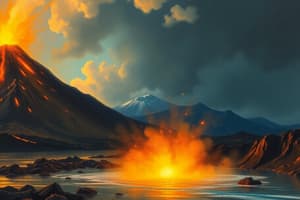Podcast
Questions and Answers
Which type of volcano is characterized by a broad, gently sloping profile and effusive eruptions?
Which type of volcano is characterized by a broad, gently sloping profile and effusive eruptions?
- Cinder cone
- Composite volcano
- Shield volcano (correct)
- Stratovolcano
What is the primary mechanism by which geothermal power plants convert the Earth's internal heat into electricity?
What is the primary mechanism by which geothermal power plants convert the Earth's internal heat into electricity?
- Harnessing the pressure of the hot water or steam to directly spin turbines
- Using the heat to melt metal that then spins turbines
- Capturing the heat to boil water, which then drives turbines connected to generators (correct)
- Burning the hot water or steam directly to generate steam that drives turbines
What is the primary benefit of using geothermal energy to generate electricity compared to other renewable energy sources?
What is the primary benefit of using geothermal energy to generate electricity compared to other renewable energy sources?
- Geothermal power plants have a smaller environmental footprint than other renewable energy technologies.
- Geothermal energy is a more abundant and widely available resource compared to other renewable sources.
- It is more cost-effective to install and maintain geothermal power plants.
- Geothermal energy is a more reliable and consistent source of electricity than other renewables. (correct)
Which type of volcano is characterized by a steep, symmetrical cone and explosive eruptions due to the buildup of viscous, gas-rich magma?
Which type of volcano is characterized by a steep, symmetrical cone and explosive eruptions due to the buildup of viscous, gas-rich magma?
What type of volcano is Mount Pinatubo known as?
What type of volcano is Mount Pinatubo known as?
Which type of volcano is characterized by the accumulation of ash and lava fragments?
Which type of volcano is characterized by the accumulation of ash and lava fragments?
What role do volcanic eruptions play in the context of geothermal energy?
What role do volcanic eruptions play in the context of geothermal energy?
Which type of volcano has the widest base and gentle slopes?
Which type of volcano has the widest base and gentle slopes?
In terms of renewable energy sources, what role will geothermal power plants play?
In terms of renewable energy sources, what role will geothermal power plants play?
Which of the following is NOT a property of parallelograms?
Which of the following is NOT a property of parallelograms?
If a quadrilateral has both pairs of opposite sides parallel, what type of quadrilateral is it?
If a quadrilateral has both pairs of opposite sides parallel, what type of quadrilateral is it?
In a parallelogram, the diagonals intersect at what angle?
In a parallelogram, the diagonals intersect at what angle?
Which of the following quadrilaterals has all sides equal in length and all angles equal in measure?
Which of the following quadrilaterals has all sides equal in length and all angles equal in measure?
If a quadrilateral has one pair of opposite sides parallel and the other pair of opposite sides not parallel, what type of quadrilateral is it?
If a quadrilateral has one pair of opposite sides parallel and the other pair of opposite sides not parallel, what type of quadrilateral is it?
What is the sum of the interior angles of a quadrilateral?
What is the sum of the interior angles of a quadrilateral?
Flashcards are hidden until you start studying
Study Notes
Volcanoes and Geothermal Energy
Introduction
Volcanoes play a crucial role in shaping our planet, from creating new landmasses and altering the climate to providing valuable resources like geothermal energy. With increasing concerns about climate change and the search for renewable energy sources, understanding the relationship between volcanoes and geothermal energy becomes essential.
Volcanic Eruptions
Volcanic eruptions occur when magma, gases, and other materials rise from deep within the Earth's mantle and forcefully exit the Earth's surface. Eruptions vary greatly in scale, from gentle effusions to catastrophic explosions. While eruptions pose dangers such as ashfall, pyroclastic flows, and lahars, they also contribute to the formation of soil and create nutrient-rich ecosystems.
Geothermal Power Plants
Geothermal power plants convert the Earth's internal heat into electricity. This process involves drilling deep wells to tap into underground reservoirs of hot water or steam. The steam produced from these underground reservoirs drives turbines connected to generators, producing electricity. Some geothermal systems also use hot water directly for heating purposes.
Types of Volcanoes
There are three main types of volcanoes based on their shape and mechanism: shield volcanoes, stratovolcanoes, and cinder cones. Shield volcanoes, like those found in Hawaii, are characterized by gentle slopes and wide bases, while stratovolcanoes, such as Mount Pinatubo, have steep slopes and are prone to explosive eruptions. Cinder cones, like Paricutín in Mexico, are the smallest and youngest volcanoes, formed by the accumulation of ash and lava fragments.
Conclusion
Volcanoes and geothermal energy are inexorably linked, with volcanic eruptions providing the foundation for harnessing the Earth's internal heat to generate electricity. As we continue to search for renewable energy sources, geothermal power plants will play an increasingly important role in our energy mix. By understanding the relationship between volcanoes and geothermal energy, we can better appreciate the power of the Earth's interior and harness it for our benefit.
Studying That Suits You
Use AI to generate personalized quizzes and flashcards to suit your learning preferences.




